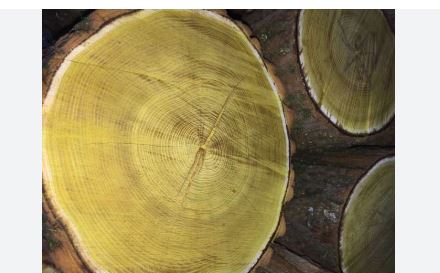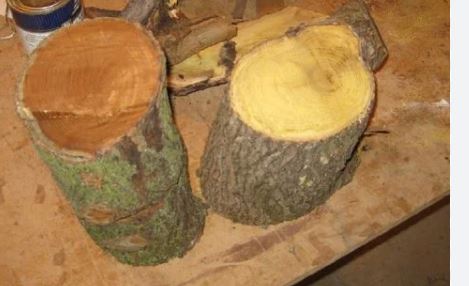
Trees with yellow wood are valued for their striking heartwood, which ranges from pale yellow to deep golden hues. These species, often found in temperate regions of North America, Europe, and Asia, belong to diverse botanical families, including hardwoods and conifers.
Indigenous peoples and early settlers used their durable, colorful wood for tools, dyes, and construction, while some species provided edible fruits or medicinal extracts. Today, the wood remains prized for furniture, crafts, and specialty items like musical instruments, with its vivid hue adding a unique touch to finished products. Cultivation began centuries ago, with selective breeding enhancing traits like color and durability.
Characteristically, these trees vary in size from small ornamentals (10-30 feet) to towering giants (over 80 feet). They feature diverse foliage, from needle-like to broad leaves, with some offering brilliant fall colors or fragrant blooms. Their wood is often hard, decay-resistant, or aromatic, making it ideal for both structural and decorative uses. Many produce fruits or seeds that support wildlife, enhancing their ecological value in landscapes.
Uses range from ornamental planting in gardens and urban settings to commercial timber production. The wood’s strength suits furniture, fencing, and paneling, while some species are used for pulp or dyes. In landscaping, they provide shade, windbreaks, or focal points, with seasonal flowers or foliage adding visual interest. Ecologically, they support pollinators and birds, though some require careful management due to invasiveness or disease susceptibility. Always select species suited to your climate and soil for optimal growth.

Trees With Yellow Wood
American Yellowwood (Cladrastis kentukea)
The American Yellowwood, native to the southeastern United States, is a medium-sized deciduous tree (30-50 feet) known for its bright yellow heartwood. Its smooth gray bark, pinnate leaves, and fragrant white wisteria-like flowers make it a popular ornamental shade tree. The wood, once used for gunstocks and dyes, is hard and polishable. It blooms every 2-3 years, attracting pollinators, and its yellow-orange fall foliage adds seasonal appeal. Ideal for gardens, it thrives in zones 4-8 but requires summer pruning to avoid sap bleeding.
Osage Orange (Maclura pomifera)
Osage Orange, native to the central United States, grows to 30-40 feet with a dense, thorny structure. Its bright yellow wood is exceptionally hard and decay-resistant, historically used for fence posts and archery bows. The tree produces inedible, bitter green fruit and has glossy green leaves that turn yellow in fall. Thriving in zones 4-9, it prefers well-drained soils and full sun. Its durability makes it a favorite for hedges and windbreaks, though its thorns require cautious handling.
Yellow Cedar (Cupressus nootkatensis)
Yellow Cedar, also known as Alaska Cedar, is a slow-growing evergreen native to the Pacific Northwest, reaching 24-40 meters. Its yellowish wood is aromatic, straight-grained, and highly decay-resistant, making it ideal for boat building and cabinetry. The tree has scale-like, bluish-green leaves and small, berry-like cones. Common in old-growth forests, it thrives in zones 4-8 in moist, well-drained soils. Indigenous peoples used its bark and wood for baskets and canoes.
Real Yellowwood (Podocarpus latifolius)
South Africa’s national tree, Podocarpus latifolius, is a large evergreen (up to 30 meters) with yellowish wood valued for furniture and paneling. Its strap-shaped leaves and edible, sweet purple arils distinguish it. Native to southern and eastern South Africa, it grows slowly in zones 7-10, preferring moist, temperate climates. The wood’s quality and the tree’s dense canopy make it a prized ornamental and timber species, though overharvesting has led to protection.
Brown Pine (Podocarpus elatus)
Native to southeastern Australia, the Brown Pine is an evergreen conifer (up to 40 meters) with yellowish-brown wood used for construction and furniture. Its narrow, dark green leaves and small, berry-like cones with edible arils are notable. Thriving in zones 8-10, it prefers coastal, well-drained soils. Its resilience and attractive foliage make it a popular ornamental in warm climates, with wood valued for its workability.
Kahikatea (Podocarpus dacrydioides)
New Zealand’s tallest native tree, Kahikatea, reaches 50-60 meters with yellowish wood used for furniture and boat building. Its scale-like leaves and small, edible red arils attract birds. Native to lowland forests, it thrives in zones 8-10 in wet, fertile soils. The tree’s cultural significance to Māori and its ecological role in wetlands make it a conservation priority, though its wood is less harvested today.
Miro (Podocarpus ferrugineus)
Another New Zealand native, Miro is an evergreen (up to 25 meters) with yellowish wood historically used for furniture. Its needle-like leaves and red, plum-like arils are distinctive. Growing in zones 8-10, it prefers moist, shaded forests. The fruit supports native birds, and the wood’s fine grain is valued in woodworking. Miro’s slow growth and ecological importance limit its commercial use today.
Totara (Podocarpus totara)
Totara, a New Zealand evergreen (up to 30 meters), has yellowish-red wood prized for Māori carvings and construction. Its needle-like leaves and red arils are key features. Thriving in zones 8-10, it grows in diverse soils and is drought-tolerant once established. Its cultural significance and durability make it a revered species, though protected due to past overharvesting.
Kusamaki (Podocarpus macrophyllus)
Kusamaki, native to China and Japan, is a medium-sized evergreen (20-40 feet) with yellowish wood used for furniture and shrines. Its broad, needle-like leaves and small, purple arils add ornamental value. It thrives in zones 7-10, preferring well-drained soils and partial shade. Popular in Asian gardens, its compact form suits hedges and topiary, with wood valued for its fine texture.
Black Locust (Robinia pseudoacacia)
Black Locust, native to eastern North America, grows to 30-50 feet with bright yellow wood that’s durable and rot-resistant, ideal for fence posts and furniture. Its fragrant white flowers and pinnate leaves make it ornamental, but it’s invasive in some areas. Thriving in zones 3-8, it tolerates poor soils. The wood’s strength and vibrant color are prized, though thorns and toxicity require caution.
Mulberry (Morus alba or Morus nigra)
Mulberry trees, native to Asia and North America, reach 30-50 feet with yellow-orange wood used for furniture and small crafts. Their heart-shaped leaves and sweet, edible berries (white, red, or black) are notable. Thriving in zones 4-9, they prefer full sun and fertile soils. The wood’s warm hue and workability make it a woodworking favorite, while the fruit attracts wildlife.
Barberry (Berberis vulgaris)
Barberry, a small deciduous tree or shrub (up to 10 feet), has yellow wood used historically for dyes and small tools. Native to Europe and Asia, it features spiny leaves, yellow flowers, and red berries. It thrives in zones 3-7 in well-drained soils. Its bright wood and ornamental qualities make it popular in gardens, though it’s invasive in some regions.
Yew (Taxus baccata)
The European Yew, an evergreen native to Europe (up to 60 feet), has yellowish-orange heartwood valued for longbows and cabinetry. Its needle-like leaves and red, berry-like arils are distinctive, though toxic. Thriving in zones 6-8, it prefers shaded, well-drained sites. The wood’s elasticity and rich color make it a woodworking staple, with dense foliage ideal for hedges.
Laburnum (Laburnum anagyroides)
Laburnum, or Golden Chain, is a small deciduous tree (15-25 feet) native to Europe with bright yellow wood used for musical instruments and inlays. Its cascading yellow flower chains and trifoliate leaves are ornamental highlights. Thriving in zones 5-7, it prefers full sun and well-drained soils. All parts are toxic, but its vibrant wood and blooms make it a garden favorite.
Kentucky Coffeetree (Gymnocladus dioicus)
The Kentucky Coffeetree, native to central and eastern North America, is a deciduous tree (60-75 feet) with yellowish heartwood used for furniture and cabinetry. Its large, bipinnate leaves and rough, scaly bark add rugged beauty, while its seed pods were historically roasted as a coffee substitute. Thriving in USDA zones 3-8, it prefers full sun and well-drained soils. The wood’s strength and warm yellow hue make it a woodworking favorite, though its seeds are toxic if unprocessed.
Boxelder (Acer negundo)
Boxelder, a fast-growing deciduous tree (30-50 feet) native to North America, has soft, yellowish wood often used for pulp, crates, and small crafts. Its compound, maple-like leaves turn yellow in fall, and it produces winged seeds. Adaptable to zones 2-9, it tolerates poor soils and urban conditions. While less valued for fine woodworking, its rapid growth and yellow wood make it a practical choice for quick shade or erosion control.
Sassafras (Sassafras albidum)
Sassafras, native to eastern North America, is a medium-sized deciduous tree (30-60 feet) with aromatic, yellowish wood used for furniture, fences, and traditional tea. Its mitten-shaped leaves turn vibrant yellow-orange in fall, and it produces dark blue drupes. Thriving in zones 4-9, it prefers well-drained, acidic soils. The wood’s warm color and fragrance, along with its ornamental foliage, make it a versatile landscape tree.
Sweetgum (Liquidambar styraciflua)
Sweetgum, native to southeastern North America, grows to 60-100 feet with yellowish to reddish heartwood used for veneer, furniture, and flooring. Its star-shaped leaves turn brilliant yellow, red, and purple in fall, and it produces spiky seed balls. Thriving in zones 5-9, it prefers moist, well-drained soils. The wood’s durability and the tree’s vibrant fall display make it a popular choice for ornamental and commercial use.
Eastern Redbud (Cercis canadensis)
Eastern Redbud, a small deciduous tree (20-30 feet) native to eastern North America, has yellowish to orange heartwood occasionally used for small crafts. Its heart-shaped leaves and vibrant pink-purple spring flowers make it a landscape favorite. Thriving in zones 4-9, it prefers partial shade to full sun. The yellow wood, though not a primary timber source, complements its stunning blooms and fall color for garden appeal.
American Elm (Ulmus americana)
American Elm, native to eastern North America, is a large deciduous tree (60-80 feet) with yellowish-brown wood used for furniture, crates, and veneer. Its vase-shaped canopy and serrated leaves are iconic, though Dutch elm disease has reduced its population. Thriving in zones 3-9, it prefers moist soils. The wood’s pale yellow tone and strength, paired with the tree’s graceful form, make it a historic favorite.
Silver Maple (Acer saccharinum)
Silver Maple, native to eastern North America, grows rapidly to 50-80 feet with soft, yellowish wood used for pulp and inexpensive furniture. Its deeply lobed leaves have silvery undersides, turning yellow in fall. Thriving in zones 3-9, it tolerates wet soils and urban conditions. While not a premium timber, its yellow wood and fast growth make it ideal for quick shade in landscapes.
Butternut (Juglans cinerea)
Butternut, or White Walnut, native to eastern North America, is a medium-sized deciduous tree (40-60 feet) with light yellow to brown wood used for furniture, paneling, and carving. Its compound leaves and edible nuts are notable, though butternut canker threatens populations. Thriving in zones 3-7, it prefers well-drained soils. The wood’s warm yellow hue and workability make it a prized hardwood.
Persimmon (Diospyros virginiana)
American Persimmon, native to eastern United States, is a medium-sized deciduous tree (35-60 feet) with yellowish heartwood used for golf club heads and small crafts. Its glossy leaves and sweet, orange fruit are distinctive. Thriving in zones 4-9, it prefers full sun and loamy soils. The wood’s durability and the tree’s ornamental and edible qualities make it a versatile choice.
Honey Locust (Gleditsia triacanthos)
Honey Locust, native to central North America, grows to 60-80 feet with yellowish to reddish-brown wood used for fence posts and furniture. Its feathery, pinnate leaves and long, twisted pods add ornamental value, while thorns (in wild forms) deter browsers. Thriving in zones 3-8, it tolerates poor soils. The wood’s strength and yellow tone, plus the tree’s airy canopy, make it a landscape and timber staple.